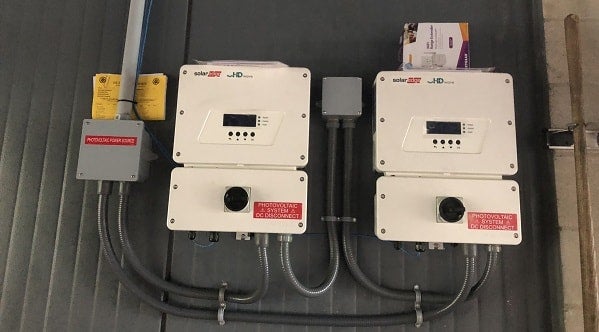Maryland co-op first to focus on battery storage

Flawn Williams first went solar in 2009 and was so impressed with his system that he expanded it in 2014—allowing his system to produce a little more than his home consumed each year. Despite the longer payback period for his system due to the slump in SREC value, he was happy with the system because it allowed him to rely less on nuclear and fossil fuels from his utility.
“But the one thing our panels and inverters don’t do for us right now is provide power during a utility power outage,” he said. That’s why Flawn joined the Maryland Storage Co-op and recently became the first participant to sign a contract to install his new battery storage system.
The Maryland Storage Co-op is the first time Solar United Neighbors has focused solely on helping solar homeowners install battery storage to enhance their existing solar systems. The co-op is open to all solar homeowners in Maryland and currently has 45 participants, and is still open to new signups. In May, a group of co-op participants selected Mountain View Solar to serve the group.
Since launching the co-op in early 2018, we’ve worked to ensure the participants understand how battery storage works, how it can be financed, and how it can be installed in your home.
While Maryland’s net metering laws limit battery storage to emergency backup, there are several financial incentives that Marylanders can take advantage of to help finance their storage system. In addition to the 30% federal investment tax credit (depending on the system configuration), the Maryland Energy Association (MEA) also launched the Tax Year 2018 Energy Storage Tax Credit Program. This program is available to residential taxpayers for systems installed during the tax year 2018, and the credit is available on a first come first serve basis until the MEA funds for the program runs out ($225,000 for residential installs). The residential tax credit can be valued up to 30% of the cost of the storage system, and no more than $5,000.
While we start the solar co-op process with a roof review to determine whether a homeowner is qualified for solar, the storage co-op process is a little different. Before an installer can give the storage co-op participant a proposal, they need a “critical load sheet” filled out. This provides a list of the appliances that the participants want to keep running (and for how long) when the power goes out and the battery system kicks on. This gives the installer a blueprint for storage system size and design.
Quang Nguyen is another Maryland Storage Co-op participant. As a research scientist, he’s passionate about technology and intrigued by the possibilities of battery storage. However, he also sees the potential benefits of adding storage to his existing solar system as well worth the expense—especially when the available incentives are factored in.
“I was on board when I found out that Maryland gave a 30% tax credit for a storage system, plus the 30% federal credit,” he said. He pointed to Vermont-based utility Green Mountain Power, which is providing incentives for rate-payers to install solar and storage systems to lower maintenance costs for everyone. “This will make the grid stronger and more reliable while preparing in case of a disaster as well,” he said.
For Flawn Williams, the decision was as simple as having peace of mind about the sun recharging his batteries when the power goes out.
“We’ll wire in circuits to power a sump pump, a freezer and refrigerator, some lights and outlets on each floor of the house, plus detectors for smoke, carbon monoxide, and intrusion alarm. That, along with our gas range and gas hot water heater, will get us through a lot of grief about lost power!”
